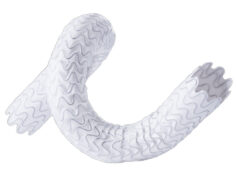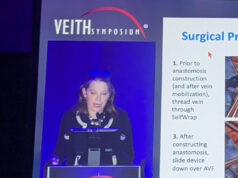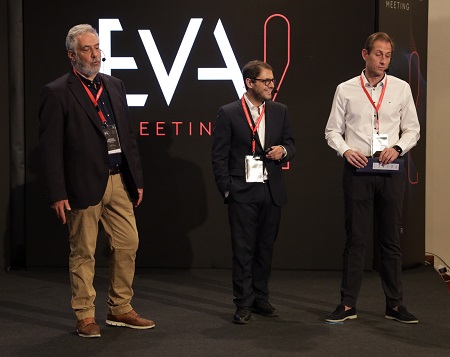
Lively discussion on unmet needs and building on quiet developments in vascular access from leading surgeons, interventional radiologists, nephrologists and interventional nephrologists formed the backbone of the recent EndoVascular Access (EVA; 24–25 June, Patras, Greece) meeting’s programme.
Practice patterns and data from around the world were brought to delegates with special sessions from the USA, with CiDA@EVA (Controversies in Dialysis Access); the Middle East with PAIRS@EVA (Pan Arab Interventional Radiology Society); and the Asia Pacific with DASy@EVA (Dialysis Access Synergy). Important developments in transplantation—such as strategies for better organ utilisation and xenotransplantation—and home haemodialysis, both of which often sit outside the traditional realm of vascular access creation, maintenance and salvage, but raise important questions on how best to manage patients with end-stage kidney disease (ESKD), were also in focus.
“There are a whole host of new procedures on the horizon, such as the percutaneous creation of arteriovenous fistulas, including those that are precision-guided. The EVA programme aimed to go beyond traditional silos in terms of specialities and topics to examine [them] from an evidence-based perspective, as they affect our understanding and management of vascular access patients. This was truly a broad-spectrum vascular access meeting with a global faculty,” EVA course directors, Dimitrios Karnabaditis, Konstantinos Katsanos and Panagiotis Kitrou (all University of Patras, Patras, Greece), told Renal Interventions.
Key trial updates were presented across the two-day programme, including on the Ellipsys vascular access system (Medtronic), the AVENEW study (BD), the first clinical experience with a new cell-impermeable endoprosthesis (Merit), and the EVA DROP study. The latest scientific research—for example, on how ‘omics’-based analysis could optimise central venous stenosis treatment—and new technologies, such as a remote monitoring system providing continuous data on several haemodialysis access metrics (Alio), were also discussed.
Catheter arms race and modulating mega fistulas

Ziv Haskal (University of Virginia, Charlottesville, USA) alluded to the 20-year arms race of catheters and emphasis on “larger and larger sizes, and coatings”, which have never been tested in head-to-head comparisons to show improvements. “And, yet, we are still focusing on those,” he said, calling for a shake-up in thinking. Turning tack to balloon maturation, he pointed out that interventionists would do well to enhance their understanding what it takes to get a fistula to mature—whether it is created by surgical or percutaneous means—and not simply use balloon angioplasty as a go-to procedure.
“I wanted to highlight that, outside of our narrow tunnel vision of the pipe, which we have to either create, maintain or make larger, there are important examples of unmet needs, such as the long-term cardiovascular consequences of high-flow fistulas in patients,” Haskal added. “We know that annual cardiovascular mortality is so very great in these patients. And, we need technology to be able to modulate those mega fistulas. On the other side of it is the systemic atherosclerosis; the extraordinary peripheral arterial disease and critical limb ischaemia that we need to be able to provide care on. We need defined approaches that are unique to this population and keep this in everyone’s minds.”
Not all stenoses are alike
Charmaine Lok’s (University of Toronto, Toronto, Canada) opening gambit made clear that “a stenosis is absolutely not necessarily the same in all patients”. “I do not think a stenosis is a stenosis is a stenosis—do you?” she asked Bart Dolmatch (Palo Alto Medical Foundation, Mountain View, USA). “I completely agree that not all stenoses are the same,” he concurred, before going further to add that discerning between different types of stenoses is a precursor to choosing the best treatment strategy. “Unless we know what we are treating, we really cannot pick the tool or choose between, say, a drug-coated balloon [DCB] or a covered stent,” he opined.

“With dialysis access, we have to understand if we are treating neointimal stenosis, fibrotic stenosis, combination or inflammatory stenosis, and there are data to say that there are all these different types,” Dolmatch continued. “Once we know that, then we will be able to figure out the best strategy for treatment. My proposition is that we do a large study using high-resolution ultrasound at the time of the intervention, use the imaging to characterise stenosis and treat these all in whatever way the operator chooses. Then, we should follow the patients for outcomes. This would allow us to look at the morphology by ultrasound and understand what the ultimate outcome is after treatment. I think that will give us great insight as to which tool or technique is best deployed.”
Untapped research areas for endoAVF
Robert Jones (Queen Elizabeth Hospital, Birmingham, UK), who is president of the Vascular Access Society of Britain and Ireland (VASBI), made the point that, while all eyes are on percutaneously created fistulas, there are still significant untapped areas for research and education in the endoAVF field.
“Patient selection is a great example,” he said, noting that most of the focus to date in this area has been on vessel mapping and size criteria, and the presence of the perforator. “More understanding of whether predialysis patients or those already on dialysis will benefit the most from endoAVF is another good example,” Jones pointed out. “And, recognising recent studies in surgical fistulas that have demonstrated major differences in fistula use and success between ethnic groups. We do not have these data for endoAVF.”
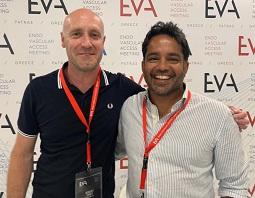
Inconsistencies in endpoint definitions are abundant in the literature, Jones also warned. “I think there does need to be some consistency with definitions moving forward, so we can make meaningful comparisons between all these different studies.” He also called for more focus on cannulation as “that is what is important to the patient”. “At the end of the day, they are the end user and, whilst we talk about the scientific side of things, there needs to be more focus, understanding and education around cannulation,” he added.
The war on access dysfunction using drugs
While the safety and efficacy of DCBs in the dialysis access space is increasingly being backed by mid-to-long-term evidence, Haskal recently took a scalpel to this evidence and warned against “optimistic overexuberance” in an interview featured in an upcoming edition of Renal Interventions. At EVA, he also spoke on the benefits of getting data from industry trials with incredibly tight populations and controlled situations, but asked Scott Trerotola (University of Pennsylvania, Philadelphia, USA): “How do you compare these populations one to the other when they all live like these beautiful, independent Greek islands? Can you take the group from one and case control into another, and then draw conclusions?”
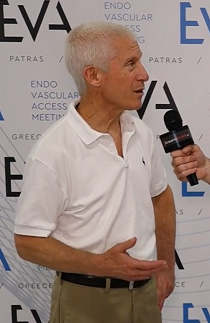
Trerotola initially qualified by saying a biostatistician would likely answer with an “absolute no”, before adding: “When you have a whole bunch of studies that have been done exactly the same way, and have the exact same signal—for example, the control group and all of these DCB studies remarkably show the same outcomes in terms of primary patency […] when you start seeing the same signal repeatedly, maybe we are really onto something.”
Elsewhere, Katsanos provided a whirlwind tour of increasing interest in the limus family of drugs, describing them as a “large group of rapamycin analogues that are cytostatic, rather than cytotoxic, which paclitaxel is”. Continuing, he noted that limus drugs offer a potential alternative to paclitaxel due to their wider therapeutic margin and mode of action. “There is a large family of ‘rapalogs’ already widely effective and used in coronary artery disease. Two randomised controlled trials of sirolimus-coated balloons in the treatment of arteriovenous fistula stenoses are currently underway with two different platforms using different doses of sirolimus, and their results are anticipated,” he concluded.
Robust as opposed to real-world angioplasty
Comparisons across studies that used different device types clearly pose an additional challenge and might even be entirely unscientific, clarified Trerotola. “Still, one of the things that has perplexed me is, if you look at the control arm of the AVENEW study, the results of plain balloon angioplasty are really quite poor. They are much lower in terms of patency than all of the control arms in these DCB trials. And why is that? Well, if you ask principal investigator Dolmatch, he will tell you it is because they did not perform the same kind of angioplasty.” In a discussion at EVA, Trerotola noted that Dolmatch had quipped that this was “real-world” angioplasty, to which Trerotola countered: “Not in my world”.
He later told Renal Interventions: “Again, you may not be able to compare these different studies, but if you can get good angioplasty, why not do it?” The theme of “good” angioplasty using a high-pressure balloon was further examined in light of the PAVE trial (which did not show a significant benefit for DCB use over angioplasty because the results of high-pressure balloon angioplasty were unexpectedly robust). PAVE principal investigator Narayan Karunanithy (Guy’s and St Thomas’ NHS Foundation Trust, London, UK) noted that “good” high-pressure balloon angioplasty for failing vascular access circuits could make all the difference. “One of the strengths of the PAVE trial is that it had independent adjudication of results by ultrasound. The idea that high-pressure balloon angioplasty for dysfunctional dialysis access circuits is a good first approach, followed by DCB, and covered stents can be reserved for bailout situations in cases where evidence is missing, might be worth exploring,” mused Kitrou.
Ultrasound poised to be ultra-important
In his presentations, Stavros Spiliopoulos (National and Kapodistrian University of Athens, Athens, Greece)—notably on the VOLA (Volume flow-guided angioplasty of dysfunctional dialysis access) pilot study—stated that ultrasound is an indispensable tool for endovascular procedures in dysfunctional vascular access. “Ultrasound provides anatomical, haemodynamic, quantitative and qualitative data, essential for accurate procedural design and intraprocedural decision-making,” he said. “Specifically, intraprocedural volume-flow measurements have recently been used as a functional endpoint that could improve angioplasty outcomes in arteriovenous fistula treatment, and lesion type characterisation using ultrasound enables individualised treatment options.”


